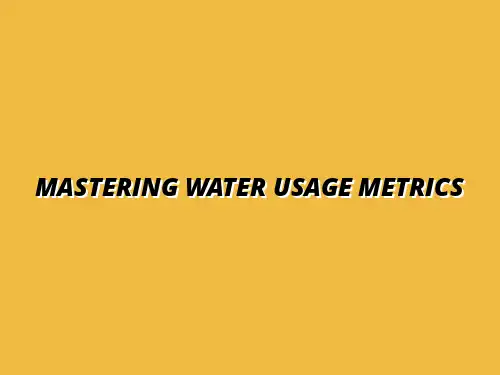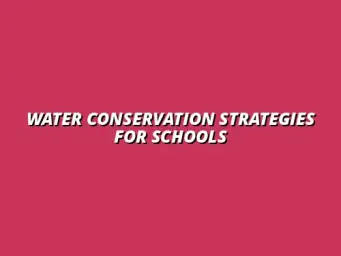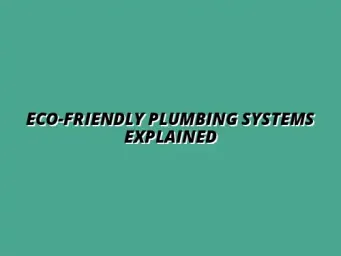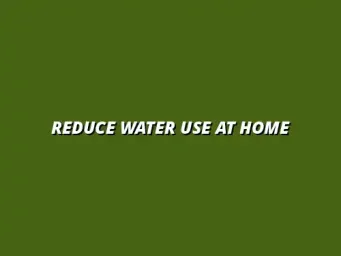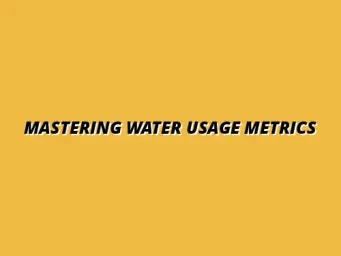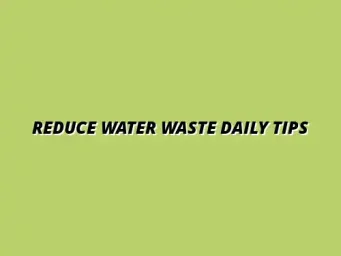The Importance of Understanding Water Usage Metrics
Understanding water usage metrics is crucial for everyone—from homeowners to business leaders. These metrics help us track how much water we use and identify areas where we can conserve. By analyzing these figures, we can make informed decisions that benefit both our wallets and the environment!
Water usage metrics vary across different settings. For example, what might be considered normal usage in a household could be quite different for a factory or a public park. Knowing these metrics can lead to targeted conservation efforts that address specific needs and challenges within various contexts. For practical tips on reducing water waste in your home, check out these daily water-saving tips.
Defining Water Usage Metrics in Different Contexts
Water usage metrics can be defined in many ways, depending on the context. In a residential setting, they often track daily consumption per household, while in commercial or industrial settings, metrics might focus on total water used for production processes. Understanding these definitions sets the stage for effective conservation strategies.
Residential Water Consumption Patterns
In homes, water consumption typically includes various activities such as showering, washing dishes, and watering gardens. Common patterns include:
- Daily personal hygiene
- Cooking and cleaning
- Outdoor usage for gardening or lawn care
By monitoring these patterns, families can identify how much water they use each month. This knowledge is the first step toward reducing waste and saving money! Learn more about effective water conservation at home.
Commercial and Industrial Water Usage
For businesses, water usage metrics are often more complex. Industries such as agriculture, manufacturing, and hospitality consume significant amounts of water. Key metrics to consider include:
- Total water used per product unit
- Water recycling rates
- Water efficiency measures in place
Understanding these metrics allows companies to identify inefficiencies, reduce costs, and implement sustainable practices that protect our precious water resources. For example, regular checks of your water pressure can significantly impact water conservation. Read more about regular water pressure checks.
Why Water Usage Metrics Matter for Conservation Efforts
Water scarcity is becoming an increasing concern worldwide. By focusing on water usage metrics, individuals and organizations can take proactive steps to address this critical issue. These metrics reveal where water is being wasted and guide sustainable practices that can make a real difference!
The Impact of Water Scarcity Worldwide
Water scarcity affects millions of people globally, leading to dire consequences such as:
- Decreased agricultural productivity
- Increased competition for water resources
- Higher costs for water delivery and infrastructure
Understanding and acting on water usage metrics can significantly contribute to alleviating these challenges. By conserving water, we can help ensure a more sustainable future for all!
How Metrics Influence Sustainable Practices
Metrics not only help us understand our water use but also influence sustainable practices. With clear data, individuals and organizations can:
- Set achievable water reduction goals
- Monitor progress over time
- Educate others on the importance of conservation
By integrating these metrics into daily habits, we can drive significant change and promote a culture of conservation. Simple changes in your bathroom can make a big difference. Check out these tips on conserving water in your bathroom.
Addressing Common Questions about Water Usage Metrics
Understanding water usage metrics can seem overwhelming, but I'm here to help simplify things! Many people wonder how to accurately measure their home water usage, which is essential for effective conservation. By knowing how to monitor and analyze your water consumption, you can make informed choices that positively impact both your wallet and the environment.
In this section, I will cover some practical advice and insights into the world of water metrics, ensuring you feel empowered to take action on your water usage. Let’s dive into these common queries!
How to Accurately Measure Home Water Usage?
Measuring your home’s water usage can be straightforward when you have the right tools and knowledge. One of the best ways to get started is by using a water meter, which tracks the amount of water your household consumes over time. Regularly checking your water meter can help you identify patterns and any unexpected spikes in usage.
Another helpful resource is your water billing statement. These documents often provide detailed information about your monthly consumption, allowing you to analyze trends and identify areas for improvement. Familiarizing yourself with these details can lead to better water management. Remember to also check your water heater maintenance checklist for potential leaks.
- Use a water meter to monitor daily consumption.
- Track usage patterns over several months.
- Review your water bill for insights on consumption trends.
Tips for Using Water Meters Effectively
Here are some tips to help you maximize your water meter’s effectiveness:
- Check your meter readings at the same time each week.
- Record the readings in a notebook or app for easier tracking.
- Look for any unusual increases in usage that could indicate leaks.
By keeping a close eye on your water meter, you can gain valuable insights into your consumption habits and address any issues quickly. For more water-saving tips for your home, visit this page.
Understanding Billing Statements for Better Insights
Water billing statements can be a treasure trove of information. Make sure to review the following sections for greater clarity:
- Monthly usage in gallons or cubic feet.
- Comparative data from previous months or years.
- Any additional fees or charges that may affect your bill.
Understanding these elements can give you a clearer picture of your water consumption and help you identify opportunities for conservation!
What Role Do Water Usage Metrics Play in Policy Making?
Water usage metrics are incredibly important for shaping policies that promote sustainable water management. When decision-makers understand how much water is being used, they can create laws and regulations that encourage conservation. This data-driven approach can lead to more effective strategies for addressing water scarcity.
Furthermore, accurate metrics can support funding for water conservation programs and community initiatives. By providing a clear picture of usage patterns, these metrics can foster a culture of responsibility regarding water resources. If you need a plumber, check out our services in Brandwood End, Birmingham.
- Metrics help identify regions in need of conservation efforts.
- They can drive the development of new policies.
- Data supports the allocation of funding for water projects.
Influencing Legislative Action for Water Conservation
Legislators rely heavily on data to make informed decisions. When water usage metrics reveal concerning trends, they can prompt legislative action aimed at conservation. This may include:
- Introducing stricter regulations on water usage.
- Offering incentives for water-efficient appliances.
- Funding public awareness campaigns about water conservation.
By addressing these issues proactively, we can work together to ensure sustainable water use for future generations.
Case Studies on Successful Policy Implementations
Looking at successful case studies can inspire similar initiatives elsewhere. For example, cities that have implemented tiered water pricing have often seen significant reductions in overall water usage. These policies encourage conservation by charging higher rates for excessive consumption, which motivates residents to be more mindful of their usage.
Another example includes regions that have adopted rainwater harvesting regulations, allowing residents to collect and use rainwater for irrigation. This not only conserves treated water but also creates a sense of community involvement in water management.
- Tiered pricing leads to reduced consumption.
- Rainwater harvesting promotes sustainable practices.
- Community engagement in policy matters increases awareness.
Final Thoughts on Effective Water Conservation Practices
As we wrap up this discussion on water usage metrics, it's clear that these tools are crucial for enhancing conservation efforts. By utilizing accurate measurements, communities can adopt more sustainable practices that safeguard our precious water resources. The future of water conservation relies on our collective commitment to understanding and managing our usage effectively.
Emerging technologies and trends are continually reshaping how we think about water management. By staying informed and engaged, we can make a significant impact on our environment and contribute to a more sustainable future.
The Future of Water Usage Metrics in Conservation Strategies
Looking ahead, I believe we will see exciting advancements in the way we utilize water metrics. Technologies such as smart sensors and IoT devices will play an essential role in gathering real-time data. This innovation will allow us to respond quickly to any water issues that arise, making conservation efforts more efficient.
Additionally, greater collaboration among communities can amplify the effectiveness of these strategies. Sharing successes, challenges, and insights can help others learn and adopt best practices for water conservation.
Emerging Trends in Sustainable Water Management
Some emerging trends in sustainable water management include:
- Increased use of digital platforms for tracking water usage.
- More community-based initiatives for public awareness.
- Growing interest in sustainable landscaping techniques that require less water.
These trends empower individuals and communities to take charge of their water usage and make informed choices.
How Communities Can Collaborate for Greater Impact
Community collaboration is vital for driving change. By working together, we can share resources, knowledge, and strategies for effective water conservation. Consider these collaboration efforts:
- Local workshops to educate residents about water-saving techniques.
- Group challenges to reduce water usage and compete for prizes.
- Partnerships with businesses to promote water-efficient products.
When communities unite for a common goal, the impact can be tremendous!
Call to Action: Taking Steps Towards Better Water Conservation
Now that you're equipped with valuable insights about water usage metrics, it's time to take action! I encourage you to start tracking your water usage today. It doesn't have to be daunting; small steps can lead to big changes. Use a water meter, check your bills, and look for areas to improve!
Additionally, consider exploring various resources available for further learning on water conservation techniques. Knowledge is power, and the more we learn, the better we can protect our most vital resource!
Encouraging Readers to Track Their Water Usage
Tracking your water usage is not just about being responsible; it's about making a positive difference. Keeping an eye on your consumption can lead to significant savings and promote awareness in your household. Plus, sharing your findings with friends and family can inspire them to join in!
Resources for Further Learning on Water Conservation Techniques
Here are some excellent resources to explore for more information on water conservation:
- Local government websites for conservation programs.
- Non-profit organizations focused on water sustainability.
- Online courses and workshops that teach effective water-saving practices.
Remember, every drop counts! Let's work together towards a more sustainable future.

